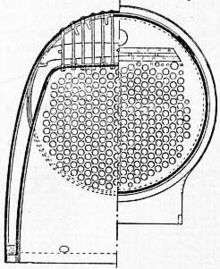Belpaire firebox
.jpg)
.jpg)

The Belpaire firebox is a type of firebox used on steam locomotives. It was invented by Alfred Belpaire of Belgium in 1864. Today it generally refers to the shape of the outer shell of the firebox which is approximately flat at the top and square in cross-section. However it is the similar square cross-section inner firebox which provides the main advantages of this design i.e. it has a greater surface area at the top of the firebox where the heat is greatest, improving heat transfer and steam production, compared with a round-top shape.
The flat firebox top would make supporting it against pressure more difficult (e.g. by means of girders, or stays) compared to a round-top. However the use of a similarly shaped square outer boiler shell allows simpler perpendicular stays to be used between the shells.[1] The Belpaire outer firebox is, nevertheless, more complicated and expensive to manufacture than a round-top version.
Description
In steam boilers, the firebox is encased in a water jacket on five sides, (front, back, left, right and top) to ensure maximum heat transfer to the water. Stays are used to support the surfaces against the high pressure between the outside wall and the interior firebox wall, and partially to conduct heat into the boiler interior.[2]
In many boiler designs, the top of the boiler is cylindrical above the firebox, matching the contour of the rest of the boiler and naturally resisting boiler pressure more easily. In the Belpaire design, the outer upper boiler wall sheets are roughly parallel with the flat upper firebox sheets giving it a squarer shape. The advantage was a greater surface area for evaporation and less susceptability to foaming and carry over of water to the cylinders compared with the narrowing upper space of a classic cylindrical boiler. This allowed Churchward of the Great Western Railway to dispense with a steam dome to collect steam. Churchward also improved the Belpaire design to maximise the flow of boiler water for a given size of boiler by tapering of the firebox and boiler barrel outwards to the area of highest steam production at the front of the firebox.
This shape also allowed easier placement of the stays which are at right angles to the sheets.
Nevertheless, other locomotive boilers, such as the LNER pacifics, had flat-top inner fireboxes with round-top outer shells with effectively as good a thermal performance as the Belpaire type and without suffering any problems of staying between shells.
In the USA, the Belpaire firebox was introduced in about 1882 or 83 by R. P. C. Sanderson, who at the time was working for the Shenandoah Valley Railway (essentially a subsidiary of the Pennsylvania Railroad, since they shared the same financial backing from E. W. Clark & Co.). Sanderson was an Englishman (later naturalized as an American citizen) who had attained his engineering degree from Cassel in Germany in 1875.
Having obtained knowledge of a special form of locomotive boiler (the Belpaire), Sanderson wrote to an old acquaintance from his college days who was working at the Henschel locomotive factory at Cassel. He sent Sanderson a tracing of Henschel's latest Belpaire boiler. When shown the design, Charles Blackwell, Superintendent of Motive Power for the Shenandoah Valley Railway, was very pleased with the design and placed an order for two passenger engines, afterwards numbered 94 and 95, and five freight engines, afterwards numbered, 56, 57, 58, 59, and 60, with the Baldwin and Grant locomotive companies. This was the beginning of the use of this type of locomotive boilers in the United States.[3] The Pennsylvania Railroad used Belpaire fireboxes on nearly all of its steam locomotives. The distinctive square shape of the boiler cladding at the firebox end of locomotives practically became a "Pennsy" trademark, as no other American railroad, except for the Great Northern, used Belpaire fireboxes in significant numbers.
In Britain, the Belpaire design was a standard feature on most Great Western Railway locomotives, and a significant number of the London, Midland and Scottish Railway's locomotives also employed the design.
Gallery
 An Australian Victorian Railways J class Belpaire firebox and boiler, in storage. A second firebox can be seen behind.
An Australian Victorian Railways J class Belpaire firebox and boiler, in storage. A second firebox can be seen behind.- British GWR Castle Class locomotive Earl Bathurst. The Belpaire firebox is the square shape in front of the cab.
- American Union Pacific Railroad steam locomotive #1500, showing the square Belpaire firebox.
 Belpaire Boiler/firebox illustrated in Scientific American in 1897.
Belpaire Boiler/firebox illustrated in Scientific American in 1897. A round top boiler and firebox shown for comparison.
A round top boiler and firebox shown for comparison.
References
- ↑ "The Belpaire Firebox". The Railway Engineer. 45: 237. April 1924. Retrieved 2014-08-22.
- ↑ By American Railway Master Mechanics' Association. "Dictionary of Terms". Locomotive Cyclopedia of American Practice. p. Page 18. Retrieved 2014-08-22.
- ↑ HAPS AND MISHAPS: The Autobiography of R. P. C. Sanderson, 1940, Philadelphia
See also
| Wikimedia Commons has media related to Belpaire fireboxes. |